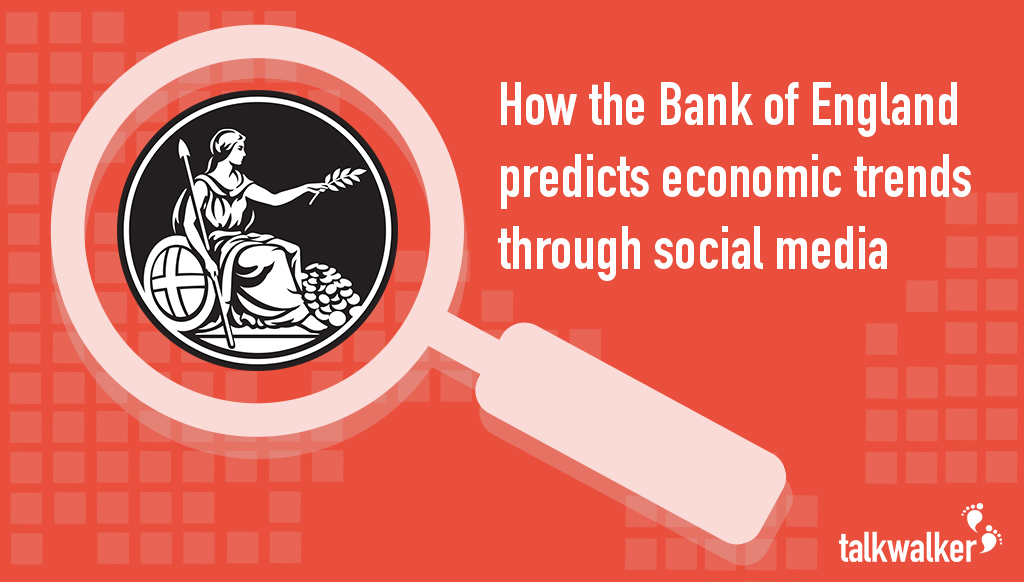Last year, the Bank of England hired Paul Robinson, a former senior Barclays foreign exchange analyst, as its first ever Head of Advanced Analytics, running a brand new data-crunching unit designed to analyse long term financial and economic risk. Paul’s objective is to marry the new unit’s output to the Bank’s monetary analysis, financial stability and supervision areas, broadening the economic projections with which to inform the Bank’s management. Predicting economic trends based on social conversations is an idea we’ve already discussed here at Talkwalker, which is why were even more interested in seeing a real-life example of social media monitoring in the finance industry.
Talkwalker caught up with Paul who was kind enough to share his thinking about the way in which the Bank uses social media analytics.
Social media has become a hot button issue for all industries. What was the motivation for the Bank of England to start data mining social attitudes?
There are three main reasons why it is important for us to monitor social networks. First of all, social media has become so much more important than say, 15 years ago. People discuss every aspect of their lives on Twitter and other networks, which gives us valuable insights into economic developments. Secondly, technology has improved greatly over the past years, both in terms of social networks and monitoring solutions. And lastly, the responsibilities of the Bank of England have become broader, in that we are now also responsible for banking and insurance regulation and other, much wider topics in finance.
What do monitoring and analytics look like at the Bank of England? Do you have a dedicated team, a dedicated platform or do you take more of an ad hoc approach?
We’re want to know how economic developments are influenced by, and reflected on, social media. If, for example, we can foresee that many people research or talk about a topic such as job seeker’s allowance, it can help us to make a prognosis about into which direction the economy is currently heading.
Then there are things we just cannot automate completely. An automated sentiment analysis for example needs to be re-checked by a person, since computers cannot recognise sentiments or patterns such as sarcasm.
Which kind of platform do you use for your social media monitoring?
As far as tools are concerned, we use a combination of internal solutions and different software packages, which we also revisit regularly. We have found that different tools have different strengths and weaknesses for specific purposes. Since we’re looking for broad insights on the state of the economy, frequently refreshing our monitoring solutions ensures that we get a full overview of what people say online.
For our monitoring results, we have created a clustering mechanism to group different topics according to the needs of our different departments. We have a dedicated team in our press department, and obviously want to extract different types of information for our data analysts and economists, so we have to keep the different requirements of each department in mind.
What is your overall experience? Are you satisfied with, and how reliable are, the results you derive from social listening?
I would say it really depends on what we are looking for specifically. I find that if we approach a topic with a positive outlook and attitude, I feel that we tend to get better results. In terms of the economy, there are three groups of topics that we want to understand. Firstly, we want an objective perspective on what influences the market. Then, of course, we also want to see what is going on with the economic and financial system itself for an accurate trends prognosis. And finally, we do ad-hoc analyses of current events on incidents that impact the economy.
Obviously, we need a holistic approach with which to ‘listen’ to people. While social media monitoring definitely helps us a great deal, we depend on it as part of a wider analysis of sources with which to build a clear picture of what is moving people at any given moment. Social media monitoring is a key part of that process.
________
With increasing numbers of people sharing their thoughts on social media and using social networks for research, centralized platforms with access to all relevant insights at a single glance are becoming more important than ever. More sophisticated networks require a growth from simple social media monitoring towards true social data intelligence. People post their emotions, thoughts and opinions. In the globalised village, social media is Earth’s biggest focus group. For banks and finance institutions, social data is then a great source to gain real-time insights into peoples’ feelings and attitudes and their impact on economic developments.
The interview took place mid-March, before the British General Election kicked off in earnest. Thank you to Mr Robinson for answering our questions and the Bank of England for providing insight into their social listening processes.

